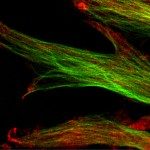Lien vers Pubmed [PMID] – 17249698
Biochemistry 2007 Feb;46(7):1878-87
During intoxication of a cell, the translocation (T) domain of the diphtheria toxin helps the passage of the catalytic domain across the membrane of the endosome into the cytoplasm. We have investigated the behavior of the N-terminal region of the T domain during the successive steps of its interaction with membranes at acidic pH using tryptophan fluorescence, its quenching by brominated lipids, and trypsin digestion. The change in the environment of this region was monitored using mutant W281F carrying a single native tryptophan at position 206 at the tip of helix TH1. The intrinsic propensity to interact with the membrane of each helix of the N-terminus of the T domain, TH1, TH2, TH3, and TH4, was also studied using synthetic peptides. We showed the N-terminal region of the T domain was not involved in the binding of the domain to the membrane, which occurred at pH 6 mainly through hydrophobic effects. At that stage of the interaction, the N-terminal region remained strongly solvated. Further acidification eliminated repulsive electrostatic interactions between this region and the membrane, allowing its penetration into the membrane by attractive electrostatic interactions and hydrophobic effects. The peptide study indicated the nature of forces contributing to membrane penetration. Overall, the data suggested that the acidic pH found in the endosome not only triggers the formation of the molten globule state of the T domain required for membrane interaction but also governs a progressive penetration of the N-terminal part of the T domain in the membrane. We propose that these physicochemical properties are necessary for the translocation of the catalytic domain.
